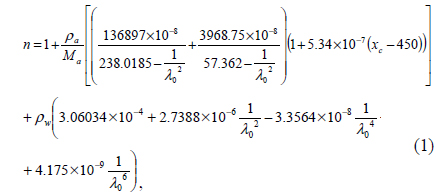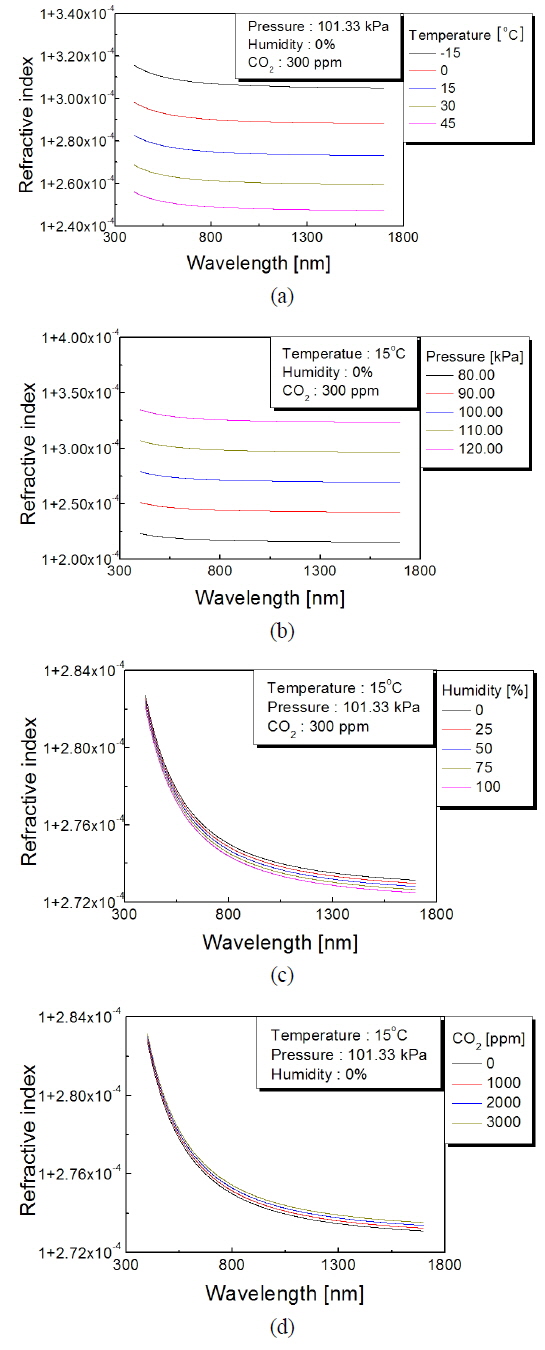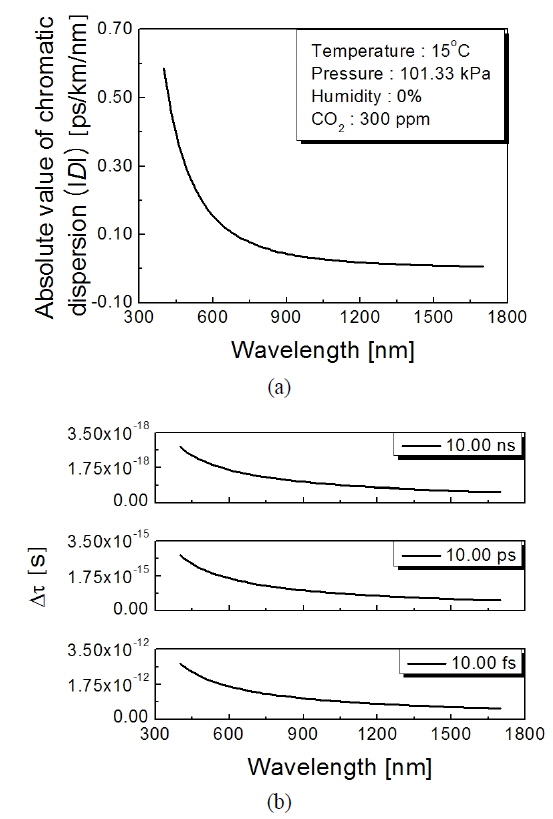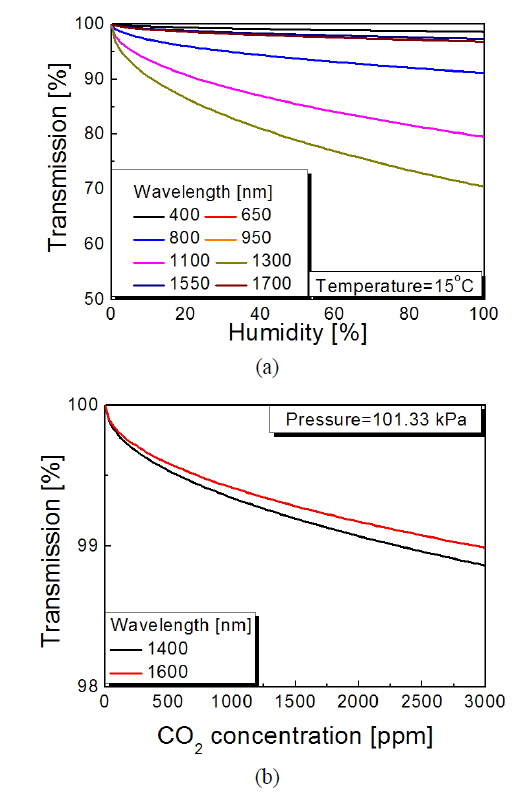



The time-of-flight laser range finder (TOF-LRF) system have been attracted in a variety of applications, such as military, geometrical surveying, robotics, and autonomous vehicles in order to measure distance precisely [1]. In the TOF-LRF system, the distance to the target is determined by measuring round trip time after propagating a pulse laser through air [1]. In the TOF-LRF system, a pulse laser with short pulse width can dramatically improve the measurement resolution of distance [2-5]. Recently, a femtosecond laser was implemented for the precise measurement of distance in the TOF-LRF system to effectively improve the resolution [6, 7]. For the TOF-LRF system, however, the main limitation of the precise measurement of distance is the unexpected property change of the pulse laser caused by the variation of the standard atmospheric conditions [8]. The measurement error of distance is usually induced by the variation of group velocity because of the pulse width broadening [8-11]. The refractive index of air is analyzed with respect to the atmospheric conditions [12, 13]. The absorption of air related to the molecules of air constituents is investigated [14-16]. However, it is not enough to analyze the propagation characteristics of the pulse laser traveling in the air including group velocity, pulse width broadening, and transmission. Therefore, it is necessary to analyze the propagation characteristics of the pulse laser propagating though the air to improve the performance of the TOF-LRF system. In this paper, we discuss the effect of atmospheric conditions on variations of optical properties of a pulse laser in the TOF-LRF system, such as the measurement error of distance, the pulse width broadening, and the transmission. The measurement error of distance in the TOF-LRF system caused by the group velocity change is analyzed by calculating the refractive index of the standard atmosphere with variations in atmospheric conditions, such as temperature, pressure, relative humidity, and the concentration of CO2. The variation of the pulse width broadening induced by chromatic dispersion of the standard atmosphere is also analyzed depending on the operating wavelength and the initial pulse width of the light source in the TOF-LRF system. The transmission of air with variations in the relative humidity or the concentration of CO2 is theoretically analyzed by using different values of absorption coefficients depending on the operation wavelength of the light source in the TOF-LRF system.
The variation of the refractive index of air with variations in atmospheric conditions, such as temperature, pressure, relative humidity, and the concentration of CO2, can be theoretically calculated. The refractive index of air (n) can be written as [13],
where,
Figures 1(a), 1(b), 1(c), and 1(d) show theoretical results for the refractive index change of air with variations in atmospheric conditions, such as temperature, pressure, humidity, and the concentration of CO2, respectively. To calculate the dependence of the refractive index of air on temperature, three parameters (pressure, humidity, and the concentration of CO2) were kept as constant at the standard atmosphere (pressure: 101.33 kPa, humidity: 0%, and the concentration of CO2: 300 ppm). The increase of temperature reduces the refractive index of air because the active thermal molecular motion in a certain volume diminishes the density of air as seen in Fig. 1(a) [13]. As temperature is changed from -15℃ to 45℃, the variation of refractive index of air is estimated to be ~5.97 × 10-5.
To analyze the effect of pressure on the refractive index of air, temperature, humidity, and the concentration of CO2 were kept constant to be 15℃, 0%, and 300 ppm, respectively. By considering the ideal gas equation, we can readily expect that the refractive index of air changes to higher values under higher pressure at constant temperature and volume. As pressure is changed from 80 kPa to 120 kPa, the total amount of refractive index variation of air is approximated to be ~1.12 × 10-4 as shown in Fig. 1 (b). By considering the group velocity of air, the target distance (
where
Temperature, pressure, and the concentration of CO2 were kept constant to be 15℃, 101.33 kPa, and 300 ppm, respectively, to calculate the variation of the refractive index of air with respect to humidity. The variation of refractive index of air is calculated to be 6.06 × 10-7 as humidity is changed from 0 to 100% as shown in Fig. 1 (c). Humidity decreases the refractive index of air because water vapor has 15% lower refractive index than dry air [17]. As the concentration of CO2 is changed from 0 to 3000 ppm for a fixed humidity of 0%, the variation of refractive index of air is calculated to be 4.53 × 10-7 as shown in Fig. 1 (d). The concentration of CO2 increases the refractive index of air because the air with CO2 has 50% higher refractive index than the air without CO2 [18]. The variation of refractive index induced by humidity and the concentration of CO2 results in maximum measurement errors of distances of 56.86 μm and 48.98 μm, respectively, for the 200-m round trip distance through air.
When a laser pulse in a TOF-LRF system propagates through a dispersive medium, the pulse width is broadened because of the chromatic dispersion of the medium. The absolute values of the chromatic dispersion (|
The theoretical result of the absolute value of the chromatic dispersion of the standard atmosphere is shown in Fig. 2(a). The chromatic dispersion of air with respect to the wavelength is changed in a range from -5.95 × 10-1 to -5.33 × 10-3 ps/km/nm. Since the chromatic dispersion depends on the wavelength, the amount of pulse width broadening should be calibrated by considering the operating wavelength of the TOF-LRF system. The amount of the pulse width broadening (Δ
where Δ
where
where
Figure 2(b) shows the variation of the amount of pulse width broadening of the pulse laser after the 200-m round trip to the target. The amount of pulse width broadening should be severely changed by the operating wavelength of the input light source because of the chromatic dispersion of the standard atmosphere. By considering Eq. (9), it is evident that the amount of the pulse width broadening (Δ
The pulse width broadening strongly depends on the initial pulse width of the input light source. Since the spectral width of the pulse laser (Δ

The amount of pulse width broadening for various pulse lasers with different initial pulse width after the 200-m round trip to the target at the operating wavelength of 1550 nm
The measurement accuracy of distance in the TOF-LRF system should be essentially affected by nonlinear refractive index depending on the optical intensity of the laser pulse [21]. The optical intensity of pulse laser required in the TOF-LRF strongly depends on a round trip distance [6, 22]. For the 200-m round trip distance, however, high power is not necessary to the pulse laser because of a relatively short distance of the round trip, and the effect of nonlinear refractive index of air on the measurement error of the round trip distance will be negligible.
A laser pulse at a certain wavelength is generally absorbed by various molecules in air. Particularly, the water vapor and the CO2 in air are strong factors for variation in the transmission of the laser pulse propagating in air [15]. The transmission of the standard atmosphere (
where
For the concentration of CO2, the transmission of the standard atmosphere (
where
We have analyzed the propagation characteristics of the pulse laser of TOF-LRF system with variations in atmospheric conditions, such as temperature, pressure, relative humidity, and the concentration of CO2. The refractive index variation of air induced by the temperature, pressure, relative humidity, and the concentration of CO2 results in a maximum distance measurement error of 6.42 mm, 12.01 mm, 56.86 μm and 48.98 μm, respectively, when the laser pulse propagates the 200-m round trip distance through air. Therefore, for the realization of the precise TOF-LRF system using the femtosecond laser, the measurement error of distance measurement error with variations in the atmospheric conditions should be corrected. We also have shown the dependence of the propagation characteristics of the pulse laser on the operating wavelength. Since the air is a dispersive medium, the pulse width should be broadened because of the chromatic dispersion of the standard atmosphere when a pulse laser propagates through the air. Considering the initial pulse width, the amount of pulse width broadening of femtosecond laser is higher than that of the nanosecond laser or picosecond laser. The absolute value of the chromatic dispersion of the standard atmosphere is diminished by increasing the operating wavelength of the pulse laser. Increasing the relative humidity gradually degrades the transmission of the standard atmosphere. The transmission of the standard atmosphere corresponding to the relative humidity is also changed by the operating wavelength of the pulse laser because of the strong dependence of the absorption coefficient (



















